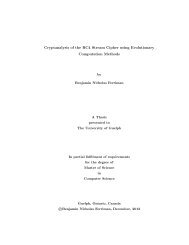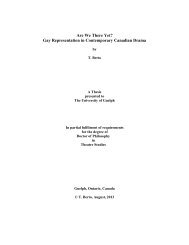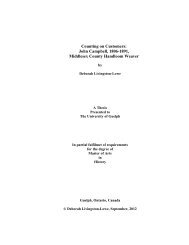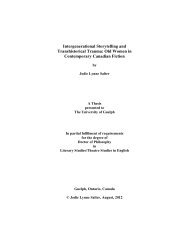THESIS - ROC CH ... - FINAL - resubmission.pdf - University of Guelph
THESIS - ROC CH ... - FINAL - resubmission.pdf - University of Guelph
THESIS - ROC CH ... - FINAL - resubmission.pdf - University of Guelph
Create successful ePaper yourself
Turn your PDF publications into a flip-book with our unique Google optimized e-Paper software.
Elongation at break (%)<br />
190<br />
170<br />
150<br />
130<br />
110<br />
90<br />
70<br />
50<br />
Figure 7.8: Elongation <strong>of</strong> SPI films blended with cellulose (F), TiO2 (Ti), and cellulose<br />
compatibilized with TiO2 (TiF)<br />
43% RH 58% RH<br />
84% RH<br />
0 0.5 1<br />
Concentration (%w/wSPI)<br />
0 0.5 1<br />
Concentration (%w/wSPI)<br />
Young’s modulus <strong>of</strong> the blend films reveal a decreasing trend with increasing RH as<br />
expected (Figure 7.9). For treatment effects, the addition <strong>of</strong> fiber and TiO2 separately yielded<br />
insignificant results. However, optimal concentration <strong>of</strong> 0.25% w/w TIO2/SPI was still found to be<br />
consistent for TiO2 at 84% RH. For TiF samples, a direct positive correlation between<br />
concentration and elasticity was not observed. However, the optimal concentration resulting with<br />
the greatest average modulus was at 1% w/wSPI consistent with tensile strength results.<br />
Further addition <strong>of</strong> TiO2-coupled fibers beyond 1% may prove to be beneficial.<br />
104<br />
0 0.5 1<br />
Concentration (%w/wSPI)<br />
F<br />
Ti<br />
TiF

















